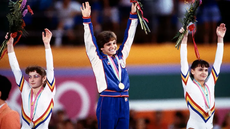Mary Lou Retton’s rare condition has exposed a dark truth
If an Olympic gold medalist can’t afford medical treatment, what hope do the rest of us have?


Your support helps us to tell the story
From reproductive rights to climate change to Big Tech, The Independent is on the ground when the story is developing. Whether it's investigating the financials of Elon Musk's pro-Trump PAC or producing our latest documentary, 'The A Word', which shines a light on the American women fighting for reproductive rights, we know how important it is to parse out the facts from the messaging.
At such a critical moment in US history, we need reporters on the ground. Your donation allows us to keep sending journalists to speak to both sides of the story.
The Independent is trusted by Americans across the entire political spectrum. And unlike many other quality news outlets, we choose not to lock Americans out of our reporting and analysis with paywalls. We believe quality journalism should be available to everyone, paid for by those who can afford it.
Your support makes all the difference.After becoming the first American woman to win the gymnastics all-around gold medal at the 1984 Summer Olympics, Mary Lou Retton appeared on a Wheaties box. That used to count for something.
Nearly four decades later, though, Retton – America’s Reagan-era sweetheart – is gravely ill in hospital. “My amazing mom, Mary Lou, has a very rare form of pneumonia and is fighting for her life,” her daughter wrote on the crowdfunding site Spotfund. “Out of respect for her and her privacy, I will not disclose all details. However, I will disclose that she is not insured.”
As of Wednesday morning, Retton’s family has raised more than $200,000 to cover her medical bills. It is a stunning example of just how beloved Retton is, but also of the generosity of the American people. The scandal is that she – like nearly 30 million other uninsured Americans and the 43 percent of those who are under-insured – are forced to beg for their lives on the internet.
Retton’s plight, then, is more than that of a famous athlete. It is indicative of structural failure in the American healthcare system. KFF, a leading source for health policy research, found this year that almost half of Americans have trouble affording healthcare; that number rises when looking at the uninsured (like Retton) or racial minorities, like I work with on the Task Force. The Commonwealth Fund reports that despite having the world’s most expensive healthcare system, we rank last among our peer nations when it comes to health outcomes. “The US has the lowest life expectancy at birth, the highest death rates for avoidable or treatable conditions, the highest maternal and infant mortality, and among the highest suicide rates,” the Commonwealth Fund stated in a separate study.
This will be unsurprising to anyone who has had to navigate this cruel and dysfunctional healthcare industry – and make no mistake, it is just that: an industry dedicated to making money, not healing humans. Most Americans, including myself and quite possibly you as well, are vulnerable to the exploitation inherent in this cumbersome and profit-driven system. Even those who we believe are well-off can be one or a handful of paychecks away from economic ruin, especially when confronted with six-figure medical debt.
The Consumer Finance Protection Bureau reports Americans owe collectively $88 billion in medical debt – but cautions that figure is likely higher. The consequences of this debt are myriad and serious: Americans drain their savings, put off college and homebuying, skip paying other bills, and frequently face financial ruin all because they dared get sick. That is if they even go to the doctor; in 2022, 40 percent of Americans skipped medical care because of the cost.
I am one of them. Despite having insurance through the marketplace established by the Affordable Care Act, I have taken falls that probably should have been seen by a doctor. Without dental insurance, I have skipped routine care that could have prevented oral health issues I have encountered. My eyeglass prescription has not been updated in years.
Far from alone, research I have conducted over the past year shows the incredible burden a profit-driven system places on some of our most vulnerable and marginalized. Since August 2022 I have been working with the Langston Centre Health Equity Taskforce in Johnson City, Tennessee to address health disparities between Black and white folks in our community. I was fortunate enough to present my findings to the US government’s Appalachian Regional Commission in Washington, DC and help organize a local health fair, which is coming up next week.
Yet I have also heard heartbreaking stories about the prohibitive cost of healthcare and prescriptions, and though my work is focused on racial inequities – people of color are more likely than white people to be uninsured – healthcare costs are something that affect all Americans. Uninsured rates are also higher in rural areas, with the KFF (a leader in healthcare research and journalism) linking this to the epidemic of rural hospital closures. It certainly makes sense when you consider that the uninsured are less likely to afford the exorbitant hospital bills which help these supposedly altruistic institutions turn a profit. Of the over 180 rural hospitals closed since 2005, five have been in Retton’s extremely rural home state of West Virginia. That number may seem small, but when you consider the long distances rural people often have to travel to receive medical attention, you begin to see the crisis.
This inherent inequity has material costs for the American people – costs that go beyond their health and wellbeing, though that should be cost enough. In researching my presentation to the ARC, I found some shocking data: the Centers for Disease Control and Prevention reports that high blood pressure, diabetes, smoking, physical inactivity, and obesity alone “cost US employers $36.4 billion a year because of employees missing days of work.” Heart disease and stroke cost American companies $147 billion annually in lost productivity. Dental disease leads to a loss of $45 billion in productivity. “This lost productivity for companies translates into lost earnings for workers,” I explained to the ARC. “Economic disparities and health disparities go hand-in-hand. The Office of Disease Prevention and Health Promotion’s Healthy People 2030 initiative reports that ‘unmet social needs, environmental factors, and barriers to accessing health care contribute to worse health outcomes for people with lower incomes.’”
None of this is new information. We’ve rehashed the topic of our inadequate healthcare system for years. What worsens the frustration, however, is that we’ve ultimately done nothing to address it. The Affordable Care Act was a step in the right direction, but the lack of a public option was a betrayal which rendered it virtually meaningless.
Americans like Retton and those I have interviewed in my work with the Task Force – hell, you and I – deserve better. We will only get better, though, when we end the politics of envy that divides the working class along racial and geographic lines and come together to demand fair and equitable healthcare, free at the point of access. Americans must stop fighting each other and start demanding a healthcare system that saves our lives without destroying them.
I pray for Retton’s speedy recovery. I also pray for a day when a world-famous athlete nor anyone else must resort to begging strangers online to receive the healthcare they desperately need. This inhumane system failed Mary Lou, and it is failing us all.



Join our commenting forum
Join thought-provoking conversations, follow other Independent readers and see their replies
Comments